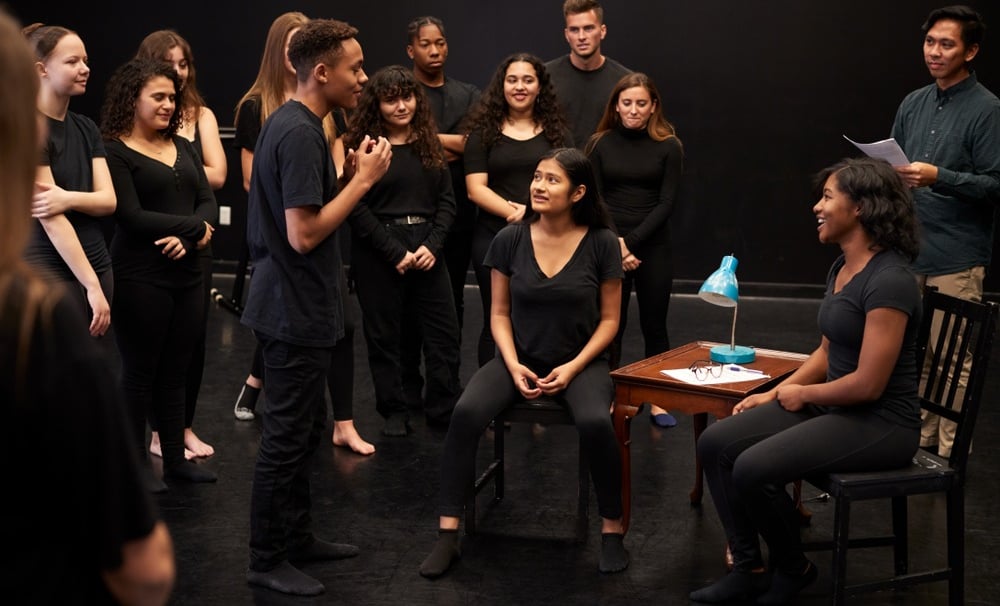Three Go-To Character Exercises for Acting
Explore three powerful character exercises for acting that help build stronger performances, from solo diary work to engaging group tableaux and physical character drills. Perfect for actors and drama teachers alike.
DRAMA TEACHER RESOURCESTHEATRE DIRECTOR RESOURCESTHEATRE STUDENT RESOURCES
Katie Zakkak
10/31/20253 min read



🎭 Whether you're an actor preparing for a role or a drama teacher/director guiding a cast through rehearsals, developing deep, believable characters is one of the most important parts of creating compelling theater.
Before we dive in—make sure to grab these free resources:
✅ Free Audition Materials Guide: Discover the 8 essential pieces you’ll need for almost any theater audition.
✅ Drama Classroom Toolkit: Directors and educators, this free resource includes a production guide, editable checklist, and more!
🌟 Interested in growing your skills? Check out my Classes & Coaching page for personalized actor training.
Why Character Exercises Matter
You know that feeling when a performance just clicks, when every actor feels present and believable? That doesn’t happen by accident. Strong acting starts with strong character work.
Today, I’m sharing my top 3 character exercises for acting. These are techniques I’ve used both as a performer and director over the last 10 years, and they’ve made a huge difference in my students’ and casts’ performances.
Whether you're working solo or in a full ensemble, these exercises can help deepen your understanding, sharpen your physical choices, and bring your characters to life.
1. Solo Exercise: Write a Diary Entry in Character
This is one of my favorite go-to solo exercises. It’s simple, flexible, and incredibly effective.
How it works:
Choose a scene you're working on.
After reading through the scene, write a diary entry as your character.
Reflect on what just happened in the scene from your character’s point of view.
How are they feeling?
Why did they respond the way they did?
Did they feel understood? Misunderstood?
This exercise works for every actor, whether you're playing the lead or a supporting ensemble role. It builds backstory, helps you clarify your character’s objective, and allows you to personalize the emotional stakes of the scene.
💡 Bonus: This can be done during rehearsal or as a homework assignment, giving students agency to develop their roles outside of scheduled practices.
2. Group Exercise: Tableau Character Stories
This one is especially useful for large group scenes or ensemble-heavy shows.
What is it?
Tableau work involves actors creating frozen images that tell a story. I used this when directing Beauty and the Beast for the opening number, Belle (Little Town).
How to try it:
Divide the cast into small groups (2–4 actors per group).
Assign a prompt (e.g. "Belle just walked by—how do your characters react?").
Have each group create three frozen poses:
A beginning
A middle
An end
Each frozen image should clearly communicate intention and emotion. Just by looking, the audience should be able to caption it luike an Instagram photo.
Once groups share their tableaux with each other, ask:
What story did you see?
What worked?
What could be even clearer?
You can even incorporate the strongest tableaux into your actual blocking. This is a great way to turn actor discoveries into production gold.
3. Mid-Rehearsal Exercise: The Chair
I recommend this exercise once actors have had some time to settle into their characters.
The setup:
Place a single chair on stage.
One at a time, actors walk onstage as their character, sit in the chair, realize they’ve forgotten something, and exit in character.
Why it works:
It’s quick, simple, and surprisingly revealing.
Let’s say you’re playing Mrs. Potts. You might hobble in, take a breath, sit, and suddenly remember—“Oh! I forgot to warm the tea!”—then rush offstage. It’s about making specific, physical, and emotional choices that match your character.
After each turn:
Fellow castmates offer one compliment and one suggestion or question.
The director gives a quick note.
This is an efficient and effective way to:
Reinforce character physicality
Build ensemble focus
Add dimension to characters who may not have many lines
Final Thoughts
The best shows are created when every actor onstage is fully engaged, regardless of their line count. These character exercises for acting are designed to support that kind of depth and commitment—from lead roles to ensemble.
Ready to take your work further?
🎯 Actors: Download the Free Audition Materials Guide
🎭 Drama Teachers/Directors: Grab your Free Drama Classroom Toolkit
🌟 Want personal support? Check out Classes & Coaching for one-on-one guidance or small group learning.
Happy acting, happy directing, and as always—break a leg!
